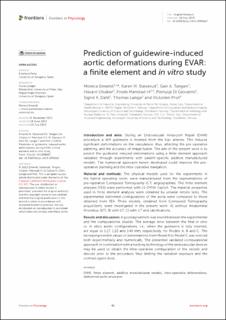| dc.description.abstract | Introduction and aims: During an Endovascular Aneurysm Repair (EVAR) procedure a stiff guidewire is inserted from the iliac arteries. This induces significant deformations on the vasculature, thus, affecting the pre-operative planning, and the accuracy of image fusion. The aim of the present work is to predict the guidewire induced deformations using a finite element approach validated through experiments with patient-specific additive manufactured models. The numerical approach herein developed could improve the pre-operative planning and the intra-operative navigation.
Material and methods: The physical models used for the experiments in the hybrid operating room, were manufactured from the segmentations of pre-operative Computed Tomography (CT) angiographies. The finite element analyses (FEA) were performed with LS-DYNA Explicit. The material properties used in finite element analyses were obtained by uniaxial tensile tests. The experimental deformed configurations of the aorta were compared to those obtained from FEA. Three models, obtained from Computed Tomography acquisitions, were investigated in the present work: A) without intraluminal thrombus (ILT), B) with ILT, C) with ILT and calcifications.
Results and discussion: A good agreement was found between the experimental and the computational studies. The average error between the final in vitro vs. in silico aortic configurations, i.e., when the guidewire is fully inserted, are equal to 1.17, 1.22 and 1.40 mm, respectively, for Models A, B and C. The increasing trend in values of deformations from Model A to Model C was noticed both experimentally and numerically. The presented validated computational approach in combination with a tracking technology of the endovascular devices may be used to obtain the intra-operative configuration of the vessels and devices prior to the procedure, thus limiting the radiation exposure and the contrast agent dose. | en_US |

